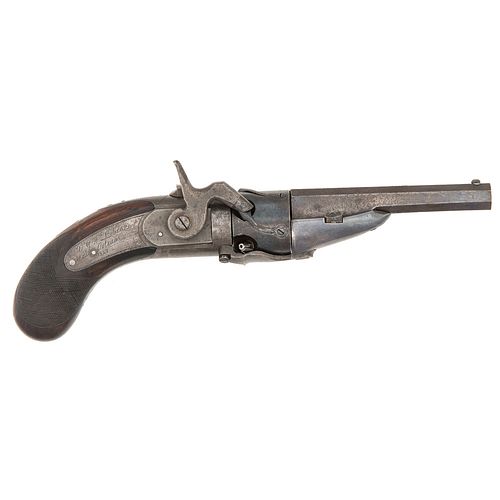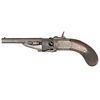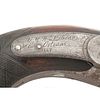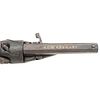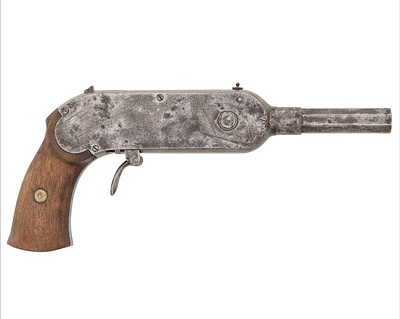Extremely Rare and Possibly Unique Southern Percussion Revolver By V.G.H. Libeau New Orleans
About Seller
6270 Este Ave.
Cincinnati , OH 45232
United States
With offices in Cincinnati, Cleveland and Denver, Cowan’s holds over 40 auctions each year, with annual sales exceeding $16M. We reach buyers around the globe, and take pride in our reputation for integrity, customer service and great results. A full-service house, Cowan’s Auctions specializes in Am...Read more
Two ways to bid:
- Leave a max absentee bid and the platform will bid on your behalf up to your maximum bid during the live auction.
- Bid live during the auction and your bids will be submitted real-time to the auctioneer.
Bid Increments
| Price | Bid Increment |
|---|---|
| $0 | $25 |
| $500 | $50 |
| $1,000 | $100 |
| $2,000 | $250 |
| $5,000 | $500 |
| $10,000 | $1,000 |
| $20,000 | $2,500 |
| $50,000 | $5,000 |
| $100,000 | $10,000 |
About Auction
May 7, 2020
Cowan’s is pleased to offer for its May 2020 Premier Auction an enviable collection of fine antique arms and military accessories. While the entire sale is indeed a showcase of rare and desirable items, several lots showcased in the May sale are of special interest to advanced collectors. Cowan's Auctions dawnie@cowans.com
- Lot Description
.36 caliber, 4.75" octagonal barrel inlaid in gold "New Orleans." Micro-groove rifling, five-shot, finely checkered bag-shaped grip of highly figured walnut. This iconic legendary percussion revolver is probably the rarest of all 19th century American percussion revolvers. It first appeared in Charles Winthrop Sawyer's book Firearms in American History (Vol II, published in 1911). Illustrated as number 11 on plate 5, and briefly described on page 81, at the time it was in the collection of Frank Sibley of Sommerville, Mass. In 1923, after his death, the Libeau revolver remained with the Sibley family when most of the collection was sold at Walpole Galleries. Later was sold by family to Howard Greene. At the NRA show held in New Orleans in 1970, it was purchased by Sam Smith and remained in his collection until his death after which it was purchased by Stan Diefenthal, then to the present consignor.
In the 1842 City Directory of Orleans Parish, V. Libeau is listed as a "gunsmith at 7 Camp Street." The history of the Libeau revolver is the subject of a lengthy article by Samuel E. Smith in the 1971 Texas Arms Annual by the equally legendary R.L. "Larry" Wilson. The Libeau revolver has an octagonal barrel boldly inlaid in large gold letters "NEW ORLEANS" and has a silver front sight. On the left flat is a uniquely designed attached loading lever and under the barrel is a heavy solid silver fore-end framing the wedge.
The 5-shot cylinder is equally unique, the chambers with engraved numbers 1 through five and curving screwed in nipples. The hammer features an elongated nozzle specifically designed to strike the offset nipples. The convex lockplate is shaped and masterfully engraved "V.G.W. Libeau New Orleans 1847." The lockplate has a saw-tooth border. The sideplate is a virtual copy of the lockplate, but without a hammer. The figured walnut butt is as finely checkered as an English dueling pistol and is inlaid with a silver thumbpiece and script owner's initials "S.B.B." The mechanism is much like a Colt Paterson as cocking the hammer indexes the cylinder and drops the folding trigger. The condition of the barrel is fine with strong traces of original bright blue and little wear. The cylinder also has strong traces of original blue finish. The lockplate and frame are smooth metal with very little corrosion or wear, the finish having drifted. The markings are excellent as is the revolving mechanism.
Provenance:Sibley family, Walpole gallery, Howard Greene, Samuel Smith, Stanley Diefenthal.The walnut butt shows wear, but retains considerable original varnish finish. The quality of the Libeau revolver is uniformly excellent rivaling the work of London's best at the same period. The bore is excellent and the revolver shows little use. The Libeau revolver is one of the most important American revolvers and one of the very finest 19th century Southern pistols ever made. It has been prized by the most famous collectors of antique American arms for more than a century and cannot be equaled in rarity by any known percussion American pistol.Condition
- Shipping Info
-
Buyers are required to pay for all packing, shipping and insurance charges. Overseas duty charges are the responsibility of the successful Bidder. Be aware that for larger and/or valuable items, shipping charges can be substantial. - If there is no shipping amount on listed your invoice, you will need to make arrangements to pick up or ship your purchase through an alternative shipping company. Our shipping department can be contacted at 513.871.1670 (ext. 219) or email shipping@cowans.com. - Shipping charges include insurance for your order while in transit. If you have private insurance we will adjust your charge to include only packing and shipping. - Please allow 14 – 21 days after payment to package and ship your purchase as carefully as possible.
-
- Buyer's Premium



 EUR
EUR CAD
CAD AUD
AUD GBP
GBP MXN
MXN HKD
HKD CNY
CNY MYR
MYR SEK
SEK SGD
SGD CHF
CHF THB
THB